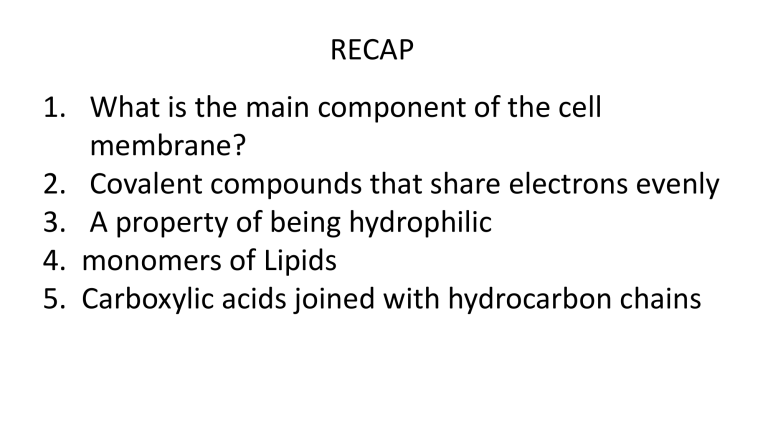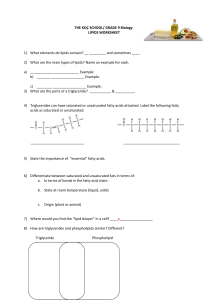
RECAP 1. What is the main component of the cell membrane? 2. Covalent compounds that share electrons evenly 3. A property of being hydrophilic 4. monomers of Lipids 5. Carboxylic acids joined with hydrocarbon chains Lipids and Membranes Lipids • • • • Also known as “fats” Large non-polar organic molecules Do not have as much Oxygen as carbohydrates No true monomer and no polymers • BUT most have fatty acids • Can be used to store energy Lipid fatty acid tail • Lipid • Saturated • What do you notice about the Carbon bonds? How is this different from the saturated lipid? Saturated vs Unsaturated Fatty Acids FATTY ACIDS =Un-branched carbon chains that make-up lipids Saturated • Saturated fatty acids have all carbons bond to 4 other atoms • S-S-S= saturated, single bond, solids UNsaturated ¢ ¢ Unsaturated fatty acids have double or triple bonds important for fluidity of cell membrane (more later) Lipids Lipids Lipids Lipids Fat à Triglyceride à Blood Stream glycerol 3 fatty acids Hypertension-chronic medical condition in which the blood pressure in the arteries is elevated. It may lead to heart attack, stroke, renal failure, and blindness. 1. Triglycerides • Fats • Most common way that animals store fat in adipose tissue • Contain 3 molecules of fatty acids joined to a polar head 2. Phospholipids • Lipids that make up cell membranes • Have two fatty acid tails that connect to a polar head • We will discuss more about these in the next unit J 3. Wax • Structural lipid made of a long fatty acid chain connected to an alcohol chain • Waterproof coating ¢Ex: plants with cuticle on leaves ¢ear wax • Function-Water proof 4. Steroids • Composed of 4 fused carbon rings • Hormones -chemical signals ¢ex testosterone estrogen or cortisol • Cholesterol is most common and is used in the cell membrane Interesting point about steroids… • How much of a difference do you see? • Small changes in functional groups allow for VERY different biological functions Testing for Lipdis • Sudan Red test • Positive • Stains lipids red & forms two layers (oil/water) • Negative • Color remains uni-form red color and one layer (just water) Cell Membrane Structure & Function Structure • Lipid Bilayer • 2 layers of phospholipids – The hydrophilic head – inside of the cell and the outside of the cell – The hydrophobic tails – face each other at the inside of the membrane What happens in oil & water –The hydrophilic head – Loves water and faces it –The hydrophobic tails – Away from the water and towards the nonpolar oil The principal components of the plasma membrane are lipids (phospholipids and cholesterol), proteins, and carbohydrates. The principal components of the plasma membrane are lipids (phospholipids and cholesterol), proteins, and carbohydrates. A micrograph from a Transmission Electron Micrograph showing a lipid vesicle. The two dark bands are the two leaflets comprising the bilayer. Fluid Mosaic Model- cell membrane • Fluid • a mixture of many different parts; able to move • Fatty acid tails-saturated & unsaturated • Mosaic • Lipids, proteins • Carbs Big Picture Cell Membrane Function • a two-dimensional liquid in which phospholipid and protein molecules diffuse easily. • protects intracellular components from the extracellular environment. (Boundary) • mediates cellular processes by regulating the materials that enter and exit the cell. (Selective Permeability) • Necessary materials in; waste & cellular products (proteins) exit Function Continued… The plasma membrane carries markers that allow cells to recognize one another and can transmit signals to other cells via receptors. (glycoprotein) Function: Cellular Transport • How things enter/leave the cell • Cell membrane is selectively permeable • Selective = choosey • Permeable = allow things to cross • Remember: Regulates what can cross the membrane like a security guard Active Transport •Endocytosis, Exocytosis, & Sodium/Potassium Pump How do things move in & out of a cell? With or Without Energy 2. Active Transport Ømovement across a cell membrane using energy Ø(ATP) Ø(usually) moves substances AGAINST their concentration gradient Øfrom LOW to HIGH concentration ØCan move HUGE molecules What do you notice about the structure of these three? 1.Endocytosis • “into the cell” • Cell membrane engulfs a particle and pinches off Vessicle transport – ENDOcytosis • Phagocytosis – • cell ‘eating’ • When a cell brings in large solid materials into the cell • Ex: white blood cells engulfing a bacteria, amoeba bringing in food Vessicle transport – ENDOcytosis • Pinocytosis – • cell ‘drinking’ • When the cell brings in BULK solutes with water Receptor-Mediated Endocytosis Plasma membrane Receptor Coat proteins Ligand 0.25 µm Coat proteins Top: A coated pit. Bottom: A coated vesicle forming during receptor-mediated endocytosis (TEMs). Coated pit Coated vesicle Forming vesicles 2.Exocytosis • “exit the cell” • Exo - outside • Removal of large amounts of material • Usually cellular products or waste • Ex: Insulin by pancreas cells, neurotransmitters from neurons Carbohydrates 3. Sodium-Potassium Pump • For normal cell function Na+ must be in higher concentration outside the cell • This pump can move 450 Na+ and 200 K+ per second





